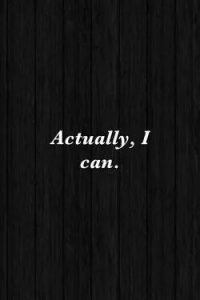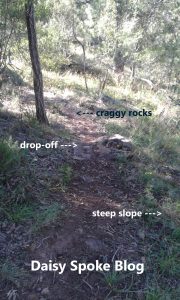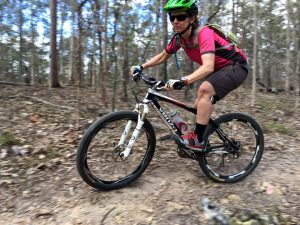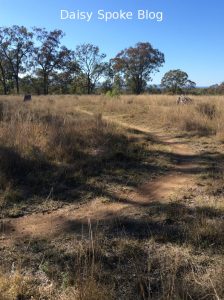
I knew I was physically capable of doing it, I’d done it several times in the past. So what was getting in the way of me ACTUALLY doing it NOW??? Over a period of a few months, the idea of riding “the scary corner” on my bike loomed bigger and scarier and I felt worse and worse. I don’t know what had changed in my mind – nothing had changed on the trail, so I figured it was some sort of powerful intra-psychic voodoo playing with my confidence and keeping me feeling small and pathetic. I couldn’t even blame it on a fall or anything like that!
 After much soul searching, I made the commitment to myself that I was going to conquer the fear that had irrationally built up in my mind. I really wanted to take charge of my fearful thoughts which seemed to be controlling my actions. It was as if my own thoughts were bullying me. The longer it went on, the worse it became. I knew that if I could get this sorted, I’d be able to transfer the skills and processes to other situations that make me nervous and better manage them as well.
After much soul searching, I made the commitment to myself that I was going to conquer the fear that had irrationally built up in my mind. I really wanted to take charge of my fearful thoughts which seemed to be controlling my actions. It was as if my own thoughts were bullying me. The longer it went on, the worse it became. I knew that if I could get this sorted, I’d be able to transfer the skills and processes to other situations that make me nervous and better manage them as well.
So here’s the 7 Step Action Plan that helped me overcome my fear of riding “the scary corner”:
- Walk it through
That’s right. The first thing I did was leave the bike behind, put on my sports shoes, and simply walk the corner – repeatedly! I familiarised myself with every stone, stick and slope. I walked it forwards and backwards. I looked at it from every possible angle. “The scary corner” and myself got to know each other well, and we gradually became friends!
- “Is anything missing?”
By getting down close and personal with the scary corner I was able to see that there was, in fact, nothing in it that I couldn’t ride. Tight left bend – check. Six inch drop over a rock – check. Angle of slope – check. Width of trail – not a problem. Nope ….. I wasn’t missing any particular skills apart from the ability to curb the fantastic stories my mind was creating about how scary the corner is! And as for equipment, well my bike is well maintained and more than capable of negotiating this terrain.

- Make modifications – physical and / or psychological
I’d been noticing that other people often lowered their seats when descending. I also noticed my own urge to get my weight lower and further back on similar corners on other trails. So, I lowered my saddle and instantly felt a lot more secure about my body position on rough descending trails. This triggered a whole new attitude of positivity and hopefulness.
- Identify your focus

Keep your eyes on the sticks, NOT the cactus or the steep slope or the rocks!
Our eyes are naturally drawn towards danger. It’s a protective mechanism which sometimes backfires on us. Mountain biking is often counter-intuitive. If you focus on the obstacle, that’s where you’ll go. To help train my eye away from the steep slope, rocks and trees that I wanted to avoid as I approached the corner, I lined the ground on the right side with small twigs to act as a visual aid (a bit like the white line marking on the road). Then I walked the trail again and again, practising keeping my eye on the twigs and not looking at the stuff I wanted to avoid!
- Practise your exit

I now began to think about actually riding the corner. But there were a couple of tricky parts and I noticed a feeling welling up inside me – the fear of getting halfway round the corner then getting trapped because I mightn’t be able to exit properly. I visualised myself falling off on the rocks and knocking my head on a tree as I tumbled down the slope and through the prickly pear. So, I needed to do something to allay my concerns. I set to work practising my exit skills on “the scary corner”. Repeatedly I walked my bike halfway round the corner so I could ride the second half of it only, over the drop-off and carefully navigate between the large protruding rocks, timing my pedal strokes just right so that I didn’t knock myself off. This built a lot more confidence and eliminated a few of the scary factors that had been distracting me.
- Make your entrance!

A short steep downhill section between and over the rocks forms the entry to the sharp-ish left hand corner.
Well now that I knew I had it all together in my head and that I could physically do it, all that was left was to make my entrance. Get down low and go, go, go! I think I even remembered to breathe, and suddenly I’d done it! In a brief second or two, I’d successfully navigated “the scary corner” and wondered what all the fuss had been about!
- Celebrate your growth
It may seem trivial to other people, and you may be the only one who truly knows what your achievement means to you. But don’t let that stop you from learning, practising, growing, and celebrating. Whatever your style – whoop out loud to the universe, punch the air, pat yourself on the back, or maybe even write a blog about it!
What things make you feel nervous? Maybe going to a meeting or party where you’re not sure if you know anyone? Going in a lift? Making a phone call that you’ve been dreading? How might the 7 Step Action Plan help you to conquer your fear or change a behaviour habit?
 Read my next blog post about applying the 7 Step Action Plan to some “everyday scenarios” that commonly get our nerves going and our minds racing.
Read my next blog post about applying the 7 Step Action Plan to some “everyday scenarios” that commonly get our nerves going and our minds racing.



